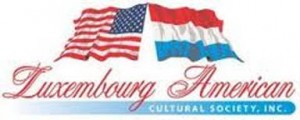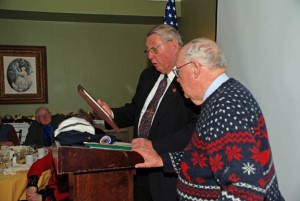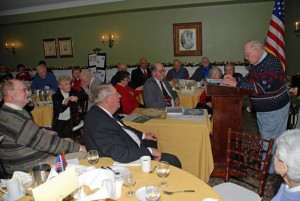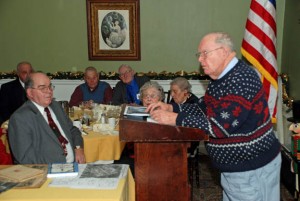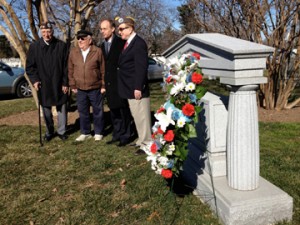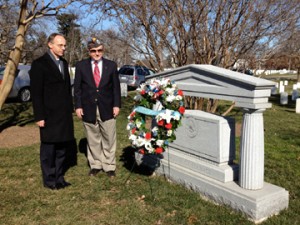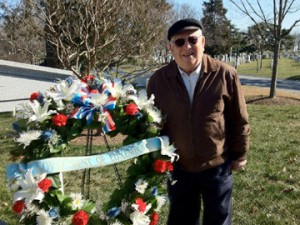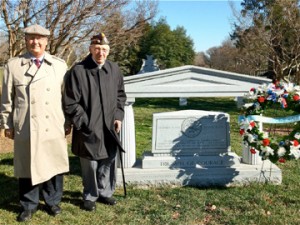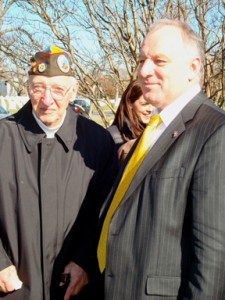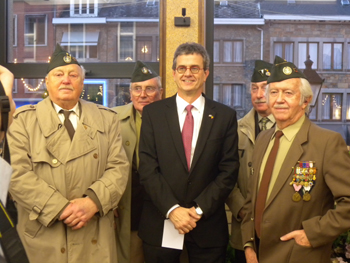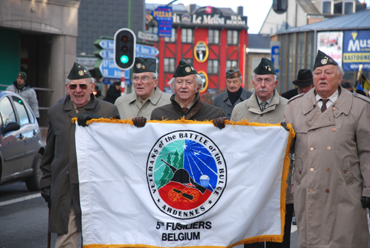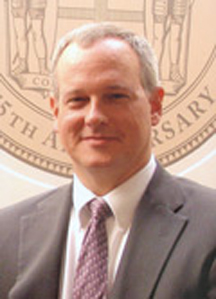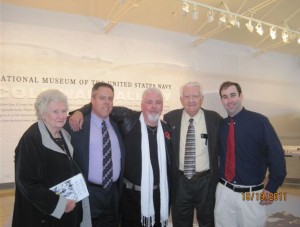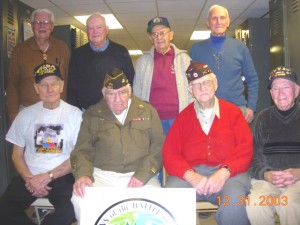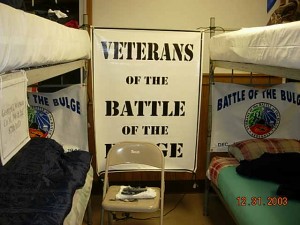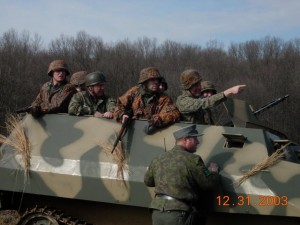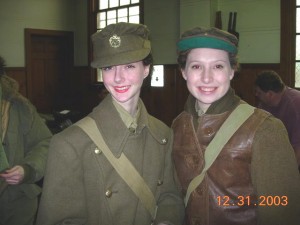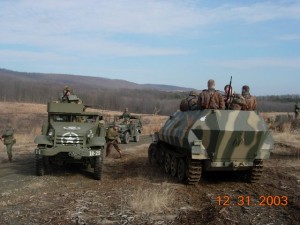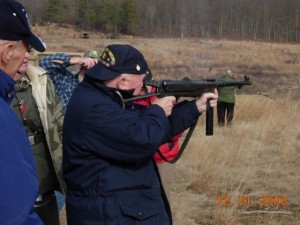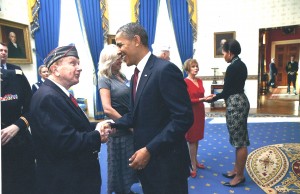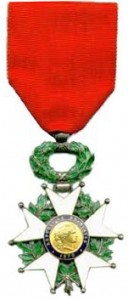“Recon, you find ’em; engineers, you fixjem; tanks, you fight ’em; and TD’s, you finish em!” With these emphatic, but crystal clear adjurations, LTC Henry L Davisson set the tempo for his task force subordnance commanders. It was 16 December 1944, and the yet-to-be-named “Ardennes Offensive” had exploded. This Kraut’s massive tank penetration now was creating this northern shoulder of what was to be its acquired sobriquet, “The Battle of the Bulge”.
In response, hastily thrown together units from the vaunted 1st INF Division, “The Big Red One,” would acquire its title “from the aggressive commander of the 634th T.D. BN.” “Task Force Davisson” was thus quickly formed as a lightly armored, tank-killing reaction force! MAJ Olson, the “TFD” S3 designated the line of march, handed out strip-maps for a southward reconnaissance. Our armored convey consisted of the 1st Recon Troop heading out with puny 37 mm armed M-8 Greyhound armored cars. Intermingled came the 1st Combat Engineer BN’s “A” Co. riding its soft-skinned vehicles. Now came “D” Co. of the 745th Tank BN with its measly LT Whippert tanks armed also with 37 mm guns, but backed up by its 75 mm assault gun platoon. Spread out and looking for targets came “C” Co. of the 634th TD BN with their 90 mm rifles, claiming the ability to compete with German armor. All ably supported by “the King of the Battlefield,” our four-man “F.O. Chaste” Arty 2 Observation party (with the common capability to call down Divarty and Corps Arty “barrages or serenades”).
Our battery veterans of the “Lucky 7th” Arty BN, who had fought German armor in Tunisia, Algeria, the beach at Sicily, and in the fields of Normandy, spoke out in warning to our little observer party: “Be ready. This TF Davisson is outgunned by the huge Panthers and King Tiger monsters reported coming your way. Remember, your tank-destroying force needs to equal or outgun those battle-tested German Behemoths and also mount sufficient armor to protect themselves from the superior German antitank weapons. In other words, you better be ‘killer tanks’ rather than tank killers. If not, you will have to stop ’em with indirect 105 mm or 155 mm Arty concentrations.”
Despite these knowledgeable words, we heard only the spumngs of COL Davisson. Quickly, the “TFD” saddled up and cautiously commenced traveling south through snowy Belgium. The lengthy convoy slid out of SourBrodt and Robertville and clanked into Walk and Weimes, small villages recently vacated by U.S. medical units. The weather was frigid cold and damp, but the fog was dissipating, and for once, Arty would have wonderfully clear observation! Here we were, “The Lucky 7th’s” forward observation party on high ground, salivating at the abundance of lucrative targets! Spotting from our town’s church steeple with our 20-power scopes, German convoys, to include tanks, traveling west across our front from 863-020 to 863-024—an artillery man’s dream!. Compounding our good fortune, our “Lucky 7th‘1 Arty BN had recently been supplied with the previously secretive ammo employing “the proximity fuse” constructed around its nose plug, which activated when the emitted radio beam encountered an object within 15 yards! We were going to have the proverbial field day .. and we deserved it!
Our parent organization, “The Fighting First,” was still recuperating from its horrific bloodletting in “The Hurtin’ Forest” this past November, where the Krauts had grounded us into Hurteen Forest and pasi^ Surely now was to be payback time … but the war gods frowned and said no, …. not yet! The American Artillery ammunition supplies across the entire 1st Army front were dangerously low, contriving to place “quotas” on all “shoots”! Our radio pleas to FDC for fire missions received a “wait out”! Our frantic telephone messages informed us their priority was to our east. There, our sister regiment, the 26th INF “Blue Spaders,” were in continuous battle with German armored thrust at Bullingen and Butenbach. There, LTC Derrill, M. Daniels, and his 2d BN would successfully blunt the German COL Piepers’ rampaging westward drive and dream! That portion of the northern shoulder would remain firm!
So now it was to be our turn. The German 1st SS Panzers, frantically searching for a route on the Rollbahnen to the west, then sideslipped and proceeded to smash at us; “TFD” now intermixed with 3d BN 16th INF at Weimes/ Our front erupted with tank fire and reported INF advancing plus intensified artillery fire in our immediate front. Our first indication was a flying buzz bomb smashing into the battery area and WIAs three gunners—CPL Homer A .Jerome, T/5 Raymond A. Fink, and PFC Erio Baton. We were further alerted by a commotion reported on our eastern outpost which luckily forewarned everyone in town! Speeding down the only street in Weimes came two G.I. jeeps overly loaded with Krauts. Firing madly and careening widely to escape our firing gallery response, they crashed off the road on the west side of the village.
COL Davisson then ordered, “Recon, send a squad to investigate and recover bodies and/or the vehicles”! LT Cangerosi, our F.O., took over the viewing scopes from our lofty OP as the submachine-armed Recon squad gingerly approached the overturned vehicles. They sprayed the area, righted a jeep, and returned with a WIA spreadeagled on the hood! Another German captive was shoved into the co-pilot’s seat, hands on his head. Arriving at the town square, now crowded with a rubbernecking G.I. throng, the Jerry prisoners held center stage! Looking like “right out of Hollywood” with his peaked hat and black leather topcoat and gloves, in excellent English, he demanded medical attention for his men! In response, someone in the crowd belted him with a rifle butt! He was saved further harm by the NCOs who held back the provoked soldiers. It appeared that in breaking through our outpost, the Germans had hailed in English, then fired and killed and wounded the surprised guards. These angry crowd members were old-time buddies of the soldier killed by this “ruse-de-guerre”!
Later, with his head now bandaged, the German officer was carted off to the 16th INF Regimental S-2, where subsequent interrogation divulged he was an officer-courier transporting the photographic proof of this German explosive and successful penetration through the American lines. The following day, angered regimental staff members descended and oversaw a search of the snowy jeep accident area and found this valuable film!
These important photos, immediately developed at the rear headquarters, received prominent world attention as the classic “Bulge” combat film showing smilincL German paratroopers as “successfulwarriors in action”! With our shooting priority reestablished and our observation still A-OK, our ARTY observer party initiated fire missions with visibly outstanding results! LT Anthony Cangelosi, our latest F.O., who would break the “bad luck cycle” of officer casualties and proceed to “make it” to the war’s end in Czechoslovakia, took targets under fire. First, we fired on “enemy troops forming for attack,” then followed a mission on enemy vehicles. Finally, we observed for a Divarty TOT on an enemy assembly area. With the horizon ablaze, we continued with harassing fires throughout the night. CPL Maurice Vacher was our instrument CPL who would be promoted and get the Purple Heart the following week. He would return, bandaged, with three new stripes and stories of great chow in the medical rear. Me, now a Tech 5th (CPL’s pay without the authority) and my cohort, T/5 Rene Cote, our dependable driver, rounded out our crew. At first light, all of us, now professionals after six months on the combat scene, poured destruction on the advancing white-painted enemy armor and accompanying white-clad infantry. After four missions and 275 rounds expended, we reported “enemy activity ceased and one tank burning”! Later, during a slow afternoon, CPT Fred F. Chirigotis from the 745th Tanks asked for our indirect fire observing so they could “use up” their 75 mm ammo. With a total expenditure, their tanks would be able to acquire new 76 mm tubes! Jumping at the chance, I got some invaluable and exhilarating shooting experience and contributed some damage, too!
During another quiet period, on Cote’s watch, he asked, “What the hell are those guys doing?” An engineering squad seemed to be laying a hasty minefield n the road leading south into the town of Faymonyille. Apparently, these engineers must have been short of mines because the engineering Sergeant had his squad scrounge up dinner plates from the nearby Belgium homes. His squad, laden with this ample supply of dishes, were pacing off the distances and placing plates face down on the road and adjoining fields. As viewers, our interest peaked. “Look at him now. He’s putting some real mines amongst those kitchen plates!” Finally, the squad members covered these actual metallic mines with large porcelain dinner platters. “Very clever, these Americans!” Those porcelain covers will inhibit the mine metallic detectors.” Later that afternoon, as it snowed, our forward area was dimpled with the ingenious defensive preparation. German counterfire re-intensified and seemed to be directed at our high ground and steeple, so we moved into town to the second floor of the town hall or barroom . .. “kaboom”! The biggest tank you ever saw blew our jeep to kingdom come. No one was hurt, but we sure were happy we had gone to church the previous Sunday! We countered with “purple smoke,” our air strike marking rounds as FDC insisted, “No aircraft available”. A couple of more rounds that “landed first, then whistled after” a nd whew, he backed out of view somewhere back into Faymonville. The troops were understandably quiet as we hurriedly plastered the town with HE and WP and set numerous fires, everyone privately hoping he was through with us good guys!
Our Chief of Detail and my boss S/SGT Joseph Desforge and Motor Sergeant “Shorty” Hofer came up during darkness with a replacement jeep. Besides replacing our food and extra radio batteries, they told us we were stopping an enemy armored attack on the northern shoulder of something called “the Battle of the Bulge”! After that illuminating information, we settled back in, but encountered some new problems. Our “posit” rounds were exploding at their maximum ordinate as premature bursts over our heads! Apparently, the sensitive fuses were set off by clouds! As if that was not enough, SGT Ringer’s howitzer, back in the firing battery area, had a muzzle burst and the gun was destroyed, but luckily, with no gunner casualties. Probably the intense cold on the metal tube and the sudden heat of the morning firing caused it. My remembrance of this December is the bitter cold, with all the troops occupied with ways of keeping warm. The approved method was putting on layers of any clothing! Many brainy GIs wrapped blanket strips over straw around their boots and created an incredibly large footprint in the snow—anything for insulation to stave off trench foot while occupying their foxholes.
During our lengthy and boring time on watch, someone mentioned, “Today’s Christmas! This’ll make our 3″^ Christmas overseas for our ‘Lucky 7th‘ Arty BN.” Cote reminisces about Christmas ’42 in Africa and on the moors in England on Christmas of ’43. LT Cangelosi celebrated by knocking out an MG position at 864-013 with two direct hits!! The Doughs cheered and waved their arms and weapons, stamping their cold feet, too, in their exposed foxholes! Afterward, when I sneaked down to the chow line in an adjoining cellar, the cooks told us “Boomers” (Arty observers), “You’re doing a bang-up job.” But more importantly, he slipped me an extra helping of meat and potatoes!
From Christmas to New Year’s, .it was just continuous fire—at “enemy troops in the open” and “enemy tanks.” Our records show we averaged over 1,800 rounds per day during the last days of December 1944! This wall of steel both harassed and hampered the enemy’s efforts to exploit and enlarge his armored thrust. Our uninterrupted night defensive fires, requested by our supported 16th INF, commenced with the coming of darkness and carried over until daybreak! Even so, another strong tank counterattack was repulsed in the vicinity of 053-013 (railroad tracks near Steinback, Belgium) by the direct fire of the 634th TDs and 74 tankers. The blackened hulks of destroyed German tanks stood out against the snow. The bodies of German infantry were not as easily discerned!
New Year’s Day opened with hordes of German aircraft strafing our positions. As usual, the poor bloody infantry suffered the casualties, and as always, it’s the new replacements! We “boomers” hid in our cellar as the bomb explosions rattled around us, watching the LT celebrate by drinking his liquor ration as we under-aged peons looked on! Rumors were now flying that we would attack Faymonville the first week of January ’45. So we took under fire all possible EN positions in the town. Methodically, we increased the destruction by dropping H.E. rounds through the roofs, then followed 9 up with W.P. to burn the houses. Most of them, however, were constructed of stone and resisted all our bombardments! Still, slowly, Faymonville was now systematically pulverized.
During that first week of January, we carefully, in conjunction with the mortars, fired in support of a patrol attempting to retrieve the body of LT McLaughin of “L” Co. KlA’d days previously. LT Cangelosi “had the word” and got us ready by checking our equipment, clothing, and footwear. “I want constant commo while on the attack” he said. “The INF is going to get us on high ground every chance they can and protect us, too.” That’s good, but for me, first I must get and be warm! Layering of clothing was the answer. So it’s long underwear, shirts, jackets, many trousers, ponchos, wrapped blanket strips over straw, and joining the “monster footprint brigade”. With a French Foreign Legion “kepi” look, I covered my helmet with a white pillow slip with a flap covering my neck!! Then I enclosed myself in a white bed sheet, a snow cape, and emerged through the slit for my head. Finally, I connected up the radio and set it on a German wooden sled with a 50-foot on/off switch for the LT’s use. We were “ready for Freddy”! Threw some cardboard ammo cartons filled with coffee, sugar, and cans of cream on the sled and loaded my pockets with “goodies”!
Now, as the last preparation, I ate everything I could of rations: crackers, cheese, meat and beans, cocoa, sugar, candy—anything for energy! “Now bring on those Krauts. I’m warm, full, and have dry feet. I can shoot, scoot, and communicate!” On 14 January 1945 with heavy snow falling, the 16th INF Regiment’s 3rd BN commanded by LTC Charles T. Homer co-mingled with portions of T.F. Davisson’s tanks assaulted Faymonville! We (with me pulling the radio sled) accompanied “I” Co., than later “L” Co. As we slowly trudged into the northeast portion of Faymonville, mines in the snow took out some of “A” Co.’s 745th tanks, but the “Doughs’ continued despite incoming mortars. The first reports were 2 KIA and 15 WIA for our 3rd BN. We stopped at nightfall and ran a line to the nearest Co. To hear reports of 70 casualties for the 3rd BN. We fired harassing missions and kept everyone awake! The next morning dawned crisp and sunny, and LT Cangelosi returned from BN briefing: “We are going to take Schoppen, the next town to the southeast. Let’s move it!” Trudging again through the snow, we encountered some woods where MG fire erupted. LT Cangelosi quieted it with an H.E. concentration! We held up in these woods with no fires, no hot chow, and tried stomping our feet all night to stay warm! Only good thing was a can of sliced peaches (kept warm in my armpit) for breakfast from my food stash!
The following day (maybe the 15th of January), we accompanied the 3d BN’s “L” Co., which seemed to be in reserve since we stepped in the footprints of the lead company! The snow was knee deep and snowing fiercely with drifts piling up. Someone passed the word down the line, “We are in a blizzard!” Observation was impossible—we cannot see anything, but better still, the Germans cannot see us either! My day consisted of struggling through the snow, laying a line back on the road, and finally meeting our Arty liaison wire crew; then splicing the line with frozen fingers and hearing the two parties conversing. We, tried bumming rides on the only vehicles moving, “Weasels,” some type of a lightweight covered track vehicle. They seem to be ambulances carrying WIA and flying their Red Cross flags. Everyone on the road now piled on a tank Dozer for a slippery, dangerous ride back, and I followed my line back into a house. Thank God, the troops had fired up a stove, and it was crowded and cozy! While LT Cangelosi and SGT Vacher observed upstairs, I dried up and tried heating my radio batteries on the stove to restore their strength: “Eureka, I think it works!”
The Arty liaison bunch gave me the bad news that “Jonsey,” “A” Bty radioman, was KlA’d when we hit Faymonville. The word was he was hit by a sniper. We were losing a lot of “Doughs,” but they were strangers to me. “Jonsey” was an Arty buddy doing my same job on the |?.0.! I had just returned a quarter-mile reel of commo wire I’d borrowed from him.
We continued through the snow at the proverbial “snail’s pace,” the “Doughs” plodding through snowdrifts, the tanks sliding and slipping off the roads. Noticed sometfops had wrapped barbed wire around their boots for traction; they claimed it worked! My salvation was my sled and wrapped boots. The LT is pleased with his constant commo as I dragged the sled. The troops were pleased with his instantaneous fire mission at any obstacle, seen or unseen. I was pleased with my available food on the sled! We entered Modersheid and fired normal missions on enemy troops, and then strangely, we gave them four missions of propaganda shells! We continued with 13 missions on enemy troops at CPs and OPs with approximately 70 hits on houses containing troops, with resulting fires. Then we continued with harassing fires throughout the night—nobody sleeps!
The next morning—don’t know the date—we commenced preparation fires prior to forward displacement, meaning “move out and drag the sled”! It seemed to be getting lighter in weight—probably from eating the rations and throwing away the used batteries. Great news! The 16th INF was squeezed out of the advance by the 18th INF, so for us, immediate support became general support, and another team took over. We were lucky—the food just about ran out! SGT Vacher quartered us in a large barn while LT Cangelosi checked with 3d BN for hot scoop! We cleaned up the equipment, gassed up the jeep, set up a stove, and cooked some liberated food! We were in heaven: no observation duties, in a warm barn, bellies full, just radio watch and waiting for the LT to take us home. . . . “kaboom”! A round came through an opening in the front wall and OUT the back wall—with a startling, crackling explosion that showered us with debris. Straw flew everywhere, and we were covered with shards of wood, powdered stone, and animal droppings! No one was physically hurt, but someone had to change their laundry! We moved next door to another barn, smaller, but with stone walls!
It was 31 January 1945, and we were pulling radio watch only while putting in land lines to Arty Liaison. Listening on the Arty net, we heard a rare command given to the guns: “BTY C, continuous fire to the right at 5-sec intervals with a converged sheath” for an expenditure of 45 rounds at the same target! Contact by telephone to my old buddies at Arty BN FOC discloses that a subsequent 18th INF patrol reports a German 6-gun battery of 150 mm abandoned their positions and guns at the coordinates of that strange concentration!
It was the beginning of February; the sun came out, and it seemed that Task Force Davisson, having halted, then chased the Germans out of Belgium, then simply faded away with the spring thaw!





